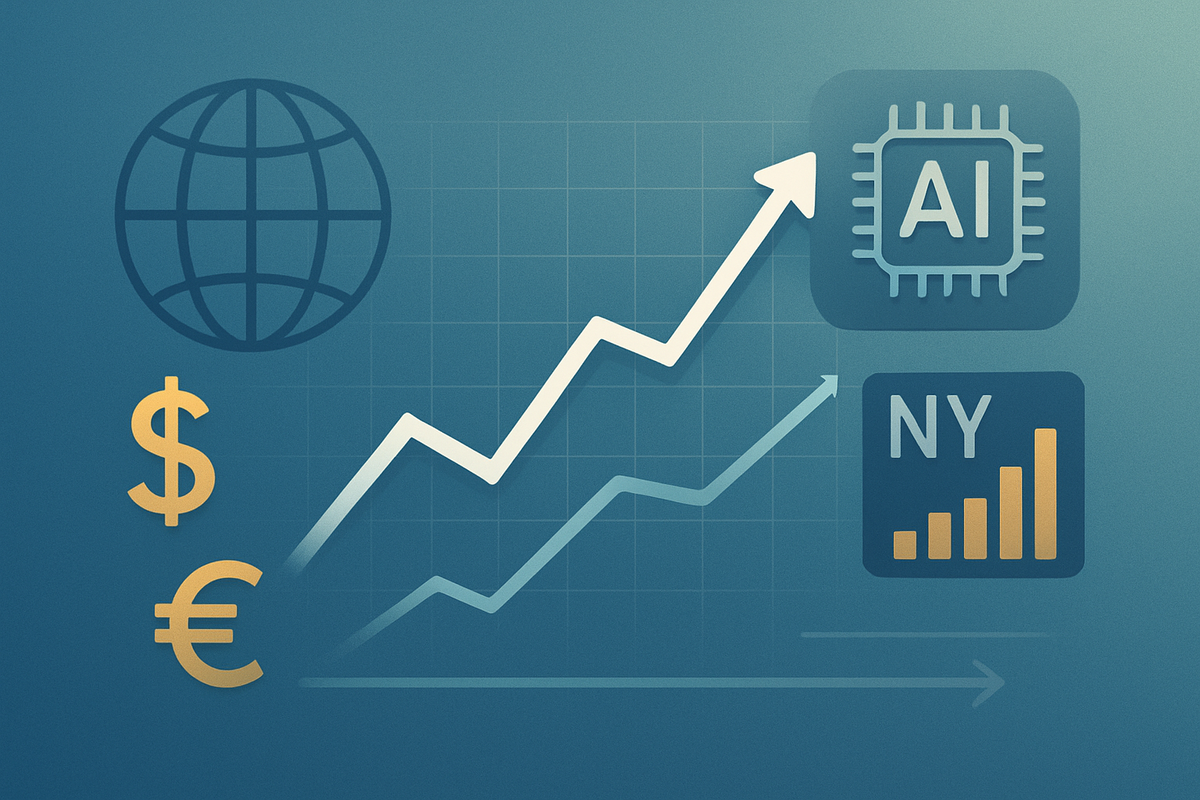
As late 2025 unfolds, global financial markets find themselves at a critical juncture, shaped by the intricate dance between evolving interest rate policies from major central banks and a landscape of robust, albeit uneven, corporate earnings. This dynamic interplay is not merely theoretical; it's actively recalibrating stock valuations, influencing investor sentiment, and redefining sector leadership across the board. The immediate implication is a market experiencing record highs, fueled by optimism around technological advancements, particularly in Artificial Intelligence, yet simultaneously grappling with heightened volatility and the looming shadow of economic uncertainties.
The current economic narrative is one of careful balancing acts: central banks attempting to fine-tune monetary policy without stifling growth, and corporations striving to maintain profitability amidst shifting economic winds. For investors, understanding the nuances of how borrowing costs impact corporate balance sheets, and how those balance sheets translate into earnings, is paramount to navigating what promises to be a complex and potentially rewarding period in the financial markets.
The Dual Forces: Central Bank Easing Meets Earnings Resilience
The current economic environment is characterized by a significant divergence in monetary policy among the world's leading central banks, set against a backdrop of surprisingly resilient corporate earnings. The Federal Reserve (Fed) in the United States has notably shifted towards an easing cycle, initiating its first rate cut in September 2025, bringing the federal funds rate to a range of 4.00%-4.25%. This move, prompted by a weakening job market and moderating inflation, is widely anticipated to be followed by further 25 basis-point reductions in October and December 2025, potentially pushing the rate to 3.75%-4.00% and then lower. Policymakers' projections hint at a sustained easing path into 2026 and 2027, with some forecasts suggesting a federal funds rate as low as 2.25%-2.50% by the end of 2027. This dovish pivot, however, is complicated by domestic policy uncertainties, including a government shutdown that has delayed crucial economic data, making the Fed's future decisions more challenging.
In stark contrast, the European Central Bank (ECB) has maintained a largely neutral stance. After a series of eight rate cuts that commenced in June 2024, the ECB's key interest rates have stabilized since June 11, 2025, with the Deposit Facility Rate at 2.00%, the Main Refinancing Rate at 2.15%, and the Marginal Lending Facility at 2.40%. The market widely expects the ECB to hold these rates steady at its upcoming October 30, 2025, meeting, marking the third consecutive hold. This reflects the Eurozone's inflation stabilizing near its 2% target, with core inflation at 2.3% in September. Unless unforeseen external shocks emerge, further ECB rate cuts are not anticipated well into 2026, with the central bank emphasizing a data-dependent approach over pre-commitment.
Meanwhile, corporate earnings have defied some expectations, exhibiting robust growth in late 2025. For the third quarter of 2025, S&P 500 companies reported a blended earnings growth rate of 9.2%, with an impressive 87% of companies exceeding EPS expectations and 83% surpassing revenue forecasts. Revenue growth hit 7.0%, the highest since Q3 2022. Analysts project continued strength, with 7.4% growth for Q4 2025 and a substantial 11.0% for the full calendar year 2025. This strength is notably concentrated in large technology firms heavily invested in Artificial Intelligence (AI), exemplified by NVIDIA (NASDAQ: NVDA), which became the first company to achieve a $5 trillion market capitalization. The financial sector is also poised for strong growth, with an estimated 38.4% earnings increase in Q4 2025. This resilience in earnings, coupled with solid consumer spending (real GDP growth of 3.8% in Q3), paradoxically provides a supportive backdrop that could allow the Fed to implement its rate cuts more gradually, should economic strength persist.
The Unfolding Narrative: Winners, Losers, and Shifting Valuations
The current environment of diverging interest rate policies and varied corporate performance creates distinct winners and losers across the market, compelling investors to reassess traditional valuation models and sector allocations.
The Winners' Circle: The primary beneficiaries of the current market dynamics are unequivocally the large-cap technology companies, particularly those at the forefront of Artificial Intelligence. Firms like NVIDIA (NASDAQ: NVDA), Microsoft (NASDAQ: MSFT), and Alphabet (NASDAQ: GOOGL) continue to demonstrate exceptional earnings growth and revenue expansion, driven by insatiable demand for AI infrastructure, software, and services. Their strong balance sheets, often characterized by significant cash reserves and less reliance on external financing for operational needs, insulate them from the direct sting of higher borrowing costs. Furthermore, their future cash flows, while still discounted, are so substantial that they can absorb higher discount rates more effectively than smaller, less established growth companies. The financial sector is also poised for significant gains, with projections of 38.4% earnings growth in Q4 2025, likely benefiting from sustained economic activity and potentially higher net interest margins in a still-elevated, albeit easing, rate environment.
The Challenged and Vulnerable: Conversely, capital-intensive industries and companies with substantial debt burdens are facing considerable headwinds. Sectors such as real estate, utilities, and certain segments of consumer discretionary are experiencing margin compression due to elevated borrowing costs. Companies in these areas, often requiring continuous investment in infrastructure or inventory, find their profitability eroded by higher interest payments on new or refinanced debt. Retailers, travel companies, and manufacturers of non-essential goods are also reporting slower transaction volumes and cautious outlooks as consumer spending begins to temper under the cumulative effect of higher rates on mortgages and credit. The energy sector, despite global geopolitical tensions, notably reported a year-over-year decline in revenues for Q3 2025, indicating broader economic pressures. Small-cap stocks, with generally higher leverage and less access to favorable financing terms than their large-cap counterparts, face a disproportionately larger risk from elevated rates, making their path to growth more arduous. High-growth companies, whose valuations are often predicated on distant future cash flows, are also particularly sensitive, as higher discount rates significantly reduce their present value, leading investors to prioritize free cash flow generation over mere top-line growth.
Broader Implications: Navigating Macroeconomic Currents
The intricate interplay between interest rates and corporate earnings extends far beyond individual company balance sheets, weaving into broader industry trends, regulatory considerations, and historical economic precedents. This dynamic is a cornerstone of the current macroeconomic narrative.
The Federal Reserve's pivot towards monetary easing, while the European Central Bank (ECB) maintains a neutral stance, highlights a significant divergence in global economic trajectories. This divergence has potential ripple effects on currency markets, with the Euro potentially strengthening against the US Dollar in the short term, impacting multinational corporations' foreign exchange revenues and costs. For companies with significant international operations, these currency fluctuations can materially affect reported earnings, adding another layer of complexity to their financial performance. The broader industry trend sees a continued bifurcation: tech-driven innovation, particularly in AI, continues to propel growth and reshape business models, while traditional, capital-intensive sectors grapple with the enduring impact of higher financing costs and potentially softening consumer demand.
Regulatory and policy implications are also at play. The ongoing government shutdown in the U.S. has introduced significant uncertainty by delaying key economic data, complicating the Fed's ability to make informed policy decisions. This uncertainty can dampen business investment and consumer confidence. Furthermore, potential changes in tax, trade, and regulatory landscapes, which are always a possibility, could further alter the operating environment for corporations, either easing or exacerbating existing pressures. The discussion around a "soft landing" for the US economy—where inflation is tamed without triggering a recession—is central to the current narrative. The resilience of corporate earnings and robust real GDP growth in Q3 2025 suggest that a soft landing remains a possibility, but the path is narrow and fraught with risks. Historically, periods of sustained high interest rates have often preceded economic slowdowns, and while the Fed is now easing, the cumulative effect of past hikes is still filtering through the economy. Comparisons to previous cycles of monetary tightening and easing suggest that the full impact on corporate profitability and consumer behavior can take time to manifest, making the current situation a delicate balancing act.
The Path Forward: Opportunities and Challenges Ahead
Looking ahead, the market's trajectory will largely depend on the continued evolution of interest rate policies, the broadening of corporate earnings growth beyond mega-cap tech, and the ability of central banks to navigate inflationary pressures without triggering a significant economic downturn.
In the short term, further rate cuts from the Federal Reserve are widely anticipated, which could provide a tailwind for equity markets by reducing borrowing costs and potentially stimulating investment and consumer spending. However, the market has largely priced in these cuts, meaning any deviation from the expected path – such as fewer cuts or a more hawkish stance due to persistent inflation – could trigger significant volatility. Long-term possibilities include a more balanced economic recovery where earnings growth broadens beyond the dominant tech sector, with double-digit growth anticipated in healthcare, industrials, and consumer discretionary in 2026. This diversification of growth drivers would be a healthy development for overall market stability.
Potential strategic pivots for corporations include a continued focus on operational efficiency and debt management, particularly for those in capital-intensive sectors. Companies may also explore opportunities in M&A, which could become more attractive as financing costs potentially decrease. Market opportunities may emerge in sectors that have been undervalued due to higher interest rates but possess strong fundamentals, such as certain segments of real estate or utilities, should rates continue to fall. Conversely, challenges include the risk of a "hard landing" if the Fed's easing is too slow or if inflation re-accelerates, forcing a reversal of policy. Geopolitical events and policy uncertainties, including the resolution of the government shutdown and potential changes in regulatory frameworks, also pose ongoing risks. The emergence of new technologies, particularly in AI, will continue to present both opportunities for innovation and challenges for companies that fail to adapt.
Navigating the Future: A Market in Transition
In summary, the financial markets in late 2025 are characterized by a dynamic tension between diverging global interest rate policies and a resilient, yet concentrated, corporate earnings environment. The Federal Reserve's pivot towards easing, contrasted with the ECB's neutral stance, underscores a complex global economic picture. While mega-cap technology companies, particularly those focused on AI, continue to drive market performance with exceptional earnings, capital-intensive sectors and highly leveraged firms face ongoing pressures from elevated borrowing costs.
Moving forward, the market's trajectory will hinge on several critical factors: the pace and extent of future Fed rate cuts, the ability of corporate earnings growth to broaden across sectors, and the successful navigation of inflationary pressures by central banks. Investors should anticipate continued volatility, particularly around central bank announcements and major earnings reports. The overarching theme is one of transition, as the market adjusts to a new interest rate paradigm and the transformative power of technological innovation.
For investors in the coming months, vigilance is key. Watch for signals from central banks regarding their future policy intentions, paying close attention to inflation data and employment figures. Monitor corporate earnings reports, especially for signs of broadening growth beyond the tech sector and for indications of how companies are managing their debt in the current rate environment. Furthermore, assess the impact of geopolitical developments and domestic policy shifts on market sentiment and sector performance. The current environment offers both significant opportunities for growth and considerable risks, demanding a nuanced and informed approach to investment.
This content is intended for informational purposes only and is not financial advice







